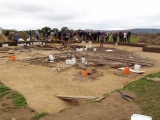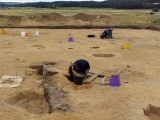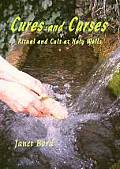<< Our Photo Pages >> Birnie Roundhouses - Misc. Earthwork in Scotland in Moray
Submitted by cosmic on Thursday, 02 October 2008 Page Views: 14667
Multi-periodSite Name: Birnie Roundhouses Alternative Name: Birnie Kirk, DykesideCountry: Scotland County: Moray Type: Misc. Earthwork
Nearest Town: Elgin
Map Ref: NJ210585
Latitude: 57.609548N Longitude: 3.323819W
Condition:
| 5 | Perfect |
| 4 | Almost Perfect |
| 3 | Reasonable but with some damage |
| 2 | Ruined but still recognisable as an ancient site |
| 1 | Pretty much destroyed, possibly visible as crop marks |
| 0 | No data. |
| -1 | Completely destroyed |
| 5 | Superb |
| 4 | Good |
| 3 | Ordinary |
| 2 | Not Good |
| 1 | Awful |
| 0 | No data. |
| 5 | Can be driven to, probably with disabled access |
| 4 | Short walk on a footpath |
| 3 | Requiring a bit more of a walk |
| 2 | A long walk |
| 1 | In the middle of nowhere, a nightmare to find |
| 0 | No data. |
| 5 | co-ordinates taken by GPS or official recorded co-ordinates |
| 4 | co-ordinates scaled from a detailed map |
| 3 | co-ordinates scaled from a bad map |
| 2 | co-ordinates of the nearest village |
| 1 | co-ordinates of the nearest town |
| 0 | no data |
Internal Links:
External Links:
It is thought that the hoards were pay-offs to the local tribes from the Romans to keep the peace. The site seems to have been occupied for several hundred years with the "main" roundhouse moving around the site as the previous one decayed.
See Current Archeology Issue 181 and RCAHMS site for more details.
Note: Chariot find at Iron Age settlement site, see latest comment.
You may be viewing yesterday's version of this page. To see the most up to date information please register for a free account.











Do not use the above information on other web sites or publications without permission of the contributor.
Click here to see more info for this site
Nearby sites
Key: Red: member's photo, Blue: 3rd party photo, Yellow: other image, Green: no photo - please go there and take one, Grey: site destroyed
Download sites to:
KML (Google Earth)
GPX (GPS waypoints)
CSV (Garmin/Navman)
CSV (Excel)
To unlock full downloads you need to sign up as a Contributory Member. Otherwise downloads are limited to 50 sites.
Turn off the page maps and other distractions
Nearby sites listing. In the following links * = Image available
421m WNW 300° Birnie Pictish Stone* Class I Pictish Symbol Stone (NJ20645872)
2.5km WSW 248° Upper Manbeen* Class I Pictish Symbol Stone (NJ1868957615)
4.4km N 9° Elgin Museum* Museum (NJ218628)
4.7km NNE 14° Elgin symbol stone* Class II Pictish Symbol Stone (NJ2219263057)
5.0km SE 137° Netherglen* Standing Stone (Menhir) (NJ24315476)
5.2km NNW 330° Quarry Wood* Henge (NJ185631)
6.0km ENE 76° Errol circle Stone Circle (NJ26905984)
6.4km NW 311° Alves Stone Circle* Stone Circle (NJ162628)
6.8km ENE 69° Bogton Mill* Stone Circle (NJ2743060765)
8.1km NE 41° Urquart Stones* Stone Circle (NJ26456450)
9.0km NW 312° Easterton of Roseisle* Class I Pictish Symbol Stone (NJ144647)
9.7km NE 54° Innesmill* Stone Circle (NJ28956407)
10.5km N 349° Gordonstoun Ogston Cross* Ancient Cross (NJ19276892)
10.7km NNW 345° Gordounstoun Class II Pictish Symbol Stone (NJ184689)
10.9km NW 322° Tappoch of Roseisle Round Cairn (NJ145673)
11.0km N 6° Drainie 3, 13, 26 Class III Pictish Cross Slab (NJ223694)
11.4km NNW 329° Inverugie Cup marked stone* Rock Art (NJ15296838)
11.4km NE 52° Binn Hill* Round Cairn (NJ30166532)
11.4km NNW 329° Camus Stone* Standing Stone (Menhir) (NJ15306840)
11.5km NNW 326° Inverugie Souterrain* Souterrain (Fogou, Earth House) (NJ148682)
11.5km NW 326° Inverugie Cup and Ring Marked rocks* Rock Art (NJ147682)
11.6km NNW 330° Inverugie* Round Cairn (NJ154687)
11.7km ESE 105° St Mary's Well (Inchberry)* Holy Well or Sacred Spring (NJ323552)
12.6km NNW 336° Clasach Cove* Class I Pictish Symbol Stone (NJ16007013)
12.7km NNW 343° Sculptor's Cave* Class I Pictish Symbol Stone (NJ175707)
View more nearby sites and additional images



 We would like to know more about this location. Please feel free to add a brief description and any relevant information in your own language.
We would like to know more about this location. Please feel free to add a brief description and any relevant information in your own language. Wir möchten mehr über diese Stätte erfahren. Bitte zögern Sie nicht, eine kurze Beschreibung und relevante Informationen in Deutsch hinzuzufügen.
Wir möchten mehr über diese Stätte erfahren. Bitte zögern Sie nicht, eine kurze Beschreibung und relevante Informationen in Deutsch hinzuzufügen. Nous aimerions en savoir encore un peu sur les lieux. S'il vous plaît n'hesitez pas à ajouter une courte description et tous les renseignements pertinents dans votre propre langue.
Nous aimerions en savoir encore un peu sur les lieux. S'il vous plaît n'hesitez pas à ajouter une courte description et tous les renseignements pertinents dans votre propre langue. Quisieramos informarnos un poco más de las lugares. No dude en añadir una breve descripción y otros datos relevantes en su propio idioma.
Quisieramos informarnos un poco más de las lugares. No dude en añadir una breve descripción y otros datos relevantes en su propio idioma.